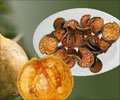Two common dietary molecules found in legumes and bran could protect DNA from the harmful effects of radiation.
Researchers from the University of Maryland have found that two common dietary molecules found in legumes and bran could protect DNA from the harmful effects of radiation. The molecules - Inositol and inositol hexaphosphate (IP6) – were tested in human skin cells and a skin cancer-prone mouse that were exposed to ultraviolet B (UVB) radiation, the damaging radiation found in sunlight.
Researchers found that the two molecules decreased the severity of side effects from radiation therapy, saving healthy cells while simultaneously increasing the potency of the treatment against cancer cells. “Both of these potent antioxidants have been shown to have broad-spectrum anti-tumor capabilities, and now our studies confirm the degree to which these molecules protect against the DNA-damaging effects of ionizing radiation,” said lead researcher Abulkalam M. Shamsuddin, M.D., professor of pathology at the University of Maryland School of Medicine.“Radiation damage is radiation damage, regardless of the source, so there could also be a protective role for IP6 in any form of radiation exposure, whether it is from a therapeutic dose or from solar, cosmic or nuclear sources.” Inositol and IP6 are related to B vitamins, they are however not considered essential dietary nutrients. They are present in abundance within the hulls of seeds and grains.
They have already been found to have definitive protective effects against colorectal cancer. With funding from IP-6 Research, Inc., a company formed by Shamsuddin, the researchers began a study to determine how human skin cells responded to UVB radiation when dosed with IP6.
Normally, cells permanently damaged by radiation undergo a genetically programmed process of cell suicide, called apoptosis. However, UVB-irradiated human keratinocytes, when treated with IP6, were more likely to survive. Untreated skin cells were more likely to undergo apoptosis, indicating that the DNA in those cells was damaged irreparably and fatally.
“IP6 certainly has some interactivity with DNA, but how exactly it works to repair DNA is still something of a mystery. There are reports that IP6 binds with DNA repair molecule Ku to bring about the repair process,” Shamsuddin said. “More importantly, we still don’t know how IP6 can appear to help healthy cells live while also enhancing the ability of radiation to kill cancer cells.”
On the study conducted on a mouse model, the researchers gave rodents engineered to be prone to skin cancer drinking water containing a two-percent solution of IP6. These rats were found to be less likely to develop tumours. Similarly, the team also noted that mice treated with a topical cream containing four percent IP6 plus one percent inositol were also less likely to develop tumours.
Advertisement
The study was reported today at the American Association for Cancer Research Centennial Conference on Translational Cancer Medicine.
LIN/V











